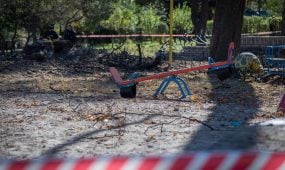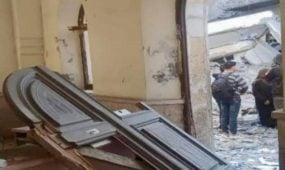Stunning Aboriginal dot paintings to travel around our Diocese
News
Three stunning interrelated Aboriginal dot paintings, representing our Diocesan Regions and commissioned by the Reconciliation Action Plan Working Group, are travelling individually around our Diocese and are being displayed as a reminder of our Christian call to Reconciliation
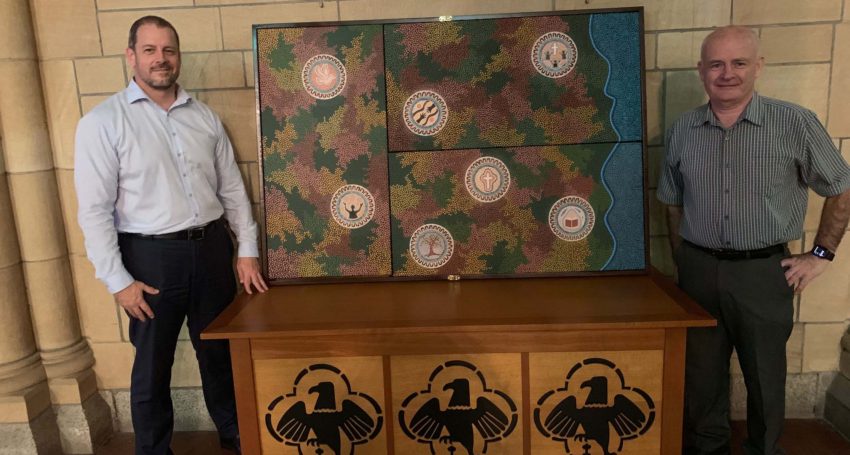
Story Timeline
Reconciliation Action Plan achievements
- Pilgrimage to Wontulp-Bi-Buya (WBB) College
- St Mark’s supporting First Nations constitutional reform
- New Anglicare SQ cards further Reconciliation journey
- PATSIMAC group creating welcome and honouring the culture of the Yugambeh people
- Anglicare’s Reconciling Histories project
- Reconciliation: relationships and respect
- Reconciliation Prayer Spaces
- SEQ Friends of Nungalinya College – building cultural bridges
- Exploring mission in a post-colonial Australian church
- First Nations ‘icons’ – a portal to Aboriginal and Torres Strait Islander Spiritualities
- Ancient Aboriginal practice meets Divine Christian call
Three stunning interrelated Aboriginal dot paintings, representing our Diocesan Regions and commissioned by the Reconciliation Action Plan Working Group, are travelling individually around our Diocese and are being displayed as a reminder of our Christian call to Reconciliation.
Each artwork represents a geographical faith Region of our Diocesan community – the Northern, Southern and Western Regions – and join together as one united piece, with the Pacific Ocean bordering the joint work’s right-hand-side.

On 12 February, our Reconciliation Action Plan Working Group met for the first time in 2020, taking the opportunity to yarn about the artwork commissioned by the Working Group. The dot paintings were created by young Kabi Kabi, Koa and Yuin artist Stevie O’Chin, with each painting representing a different Region of our Diocese and each circle representing a specific Mark of Mission. (L-R): Stephen Harrison, Tim Reid, Patrick Meuleman, Sandra King OAM, Fr Bruce Boase, Fr Richard Browning, Stephen Hart, Olly Yasso, Jean Anderson and Meredith Walker AM
The dot paintings were created by talented emerging artist Stevie O’Chin, who belongs to the Kabi Kabi and Koa peoples on her father’s side and the Yuin people on her mother’s side.
Stevie O’Chin said that the intricate circles in each artwork represent our Diocese’s Marks of Mission and share common motifs.
“Each circle has ‘U shapes’ that surround the symbols – these symbolise people gathering together to worship, and the blue dotted rings around each symbol in the circles mark the spiritual healing power of God,” Ms O’Chin said.
“The seven symbols painted within circles in the tri-Regional landscape represent the seven Marks of Mission of the Anglican Church Southern Queensland.”
The Anglican Church Southern Queensland’s seven Marks of Mission are:
- To proclaim the Good News of the Kingdom.
- To teach, baptise and nurture new believers.
- To respond to human need by loving service.
- To transform unjust structures of society, to challenge violence of every kind and pursue peace and reconciliation.
- To strive to safeguard the integrity of creation and sustain and renew the life of the earth.
- To worship and celebrate the grace of God.
- To live as one holy catholic and apostolic Church.
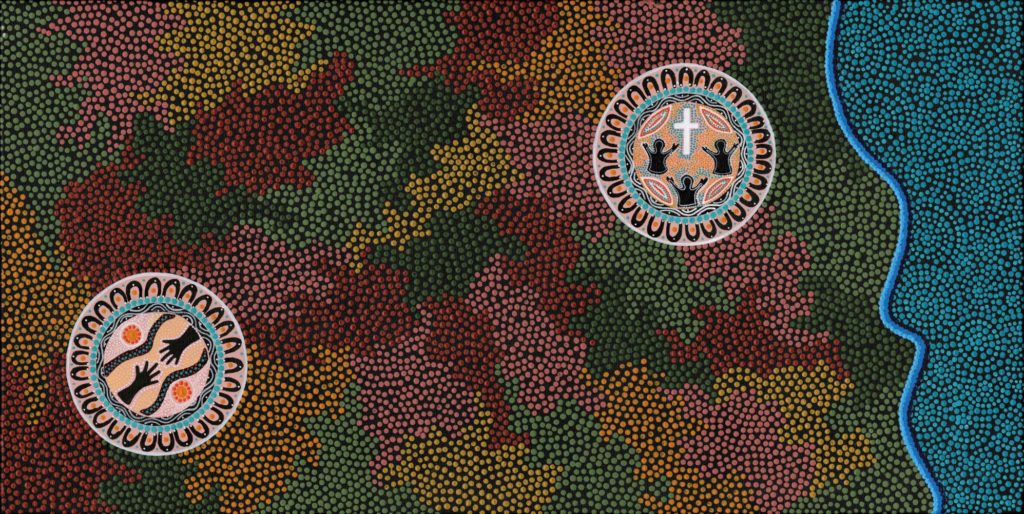
This painting represents the Northern Region, with the cross and hands (top right) symbolising ‘To worship and celebrate the grace of God’ and the two hands reaching out to each other (bottom left) symbolising ‘To respond to human need by loving service’

This painting represents the Southern Region, with the people gathered around the cross (top) symbolising ‘To live as one holy catholic and apostolic Church’, the Bible (bottom right) symbolising ‘To teach, baptise and nurture new believers’ and the tree (bottom left) symbolising ‘To strive to safeguard the integrity of creation and sustain and renew the life of the earth’
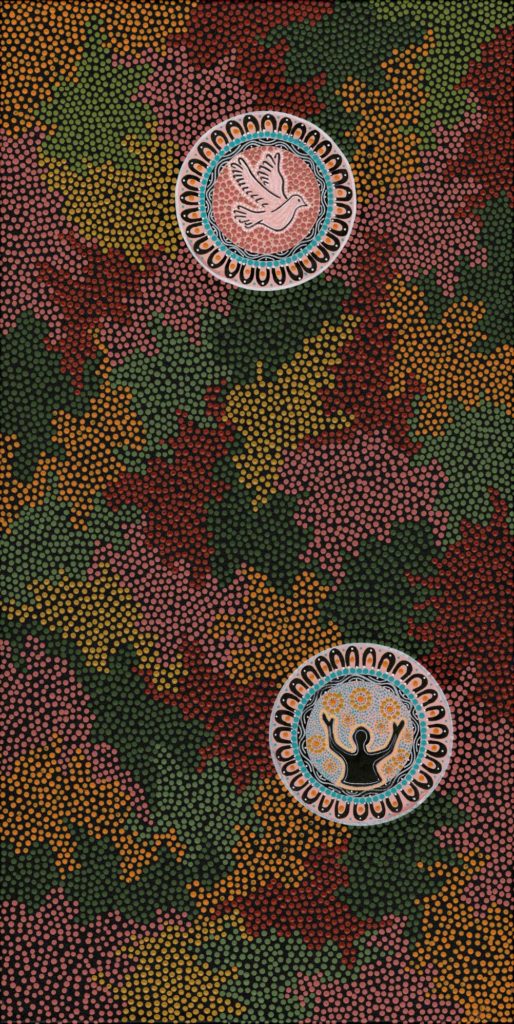
This painting represents the Western Region, with the peace dove (top) symbolising ‘To transform unjust structures of society, to challenge violence of every kind and pursue peace and reconciliation’ and the preacher (bottom) symbolising ‘To proclaim the Good News of the Kingdom’
Dot painting is an ancient and deeply symbolic practice of the world’s oldest continuously living culture, and started with sand, soil and body ‘canvases’.
Now one of the most internationally recognised Aboriginal art forms, First Nations artists commenced dot painting on framed stretched canvases in the 1970s.
Ms O’Chin said that she carries on a family legacy of Aboriginal dot painting.
“My paintings are inspired by my surroundings and stories told to me by my parents and family elders,” she said.
Advertisement
The Anglican Church Southern Queensland’s Reconciliation Action Plan (RAP) states that:
“Reconciliation is specifically identified as a key imperative within the Fourth Mark of Mission of the Anglican Communion, as part of God’s Transformation of our lives and all of Creation. Indeed, within Australian contexts, it is hard to see how justice can be done to any of the five international Marks of Mission without adequate attention and will being brought to Indigenous reconciliation issues (p. 3).”
Executive Director of Parishes and other Mission Agencies Commission and RAP Working Group member Stephen Harrison said that the three artworks support the Diocesan Reconciliation Action Plan (RAP) and symbolise our Diocesan community’s collective commitment to Reconciliation.
“By commissioning dot paintings for the commemoration of our 2020-2022 annual themes, the RAP’s ‘Actions’ to ‘engage diocese, schools and Anglicare staff in understanding and appreciating Aboriginal and Torres Strait Islander cultures, histories and achievements (p.13)’ and to ‘incorporate Aboriginal and Torres Strait Islander supplier diversity within the Church (p. 16)’ are formally embedded in our Diocesan-wide strategies and practices,” Dr Harrison said.
“These three artworks tie in directly with the Diocesan Reconciliation Action Plan and will travel around our community as a reminder of our Christian call to Reconciliation.
“At key Diocesan events the three paintings will come together as a symbol of ‘Being Together’ and that we are one Church.”
If you would like to display a dot painting relevant to your Region in your church, ministry or school, please email pmc@anglicanchurchsq.org.au.



